
Mobile App Development Services: 2025 Guide
November 21, 2025 / Bryan ReynoldsQuick Facts
- Mobile app development services include design, development, testing, and maintenance across iOS, Android, and cross-platform solutions.
- Costs range from $10,000 to $300,000 depending on complexity; most projects fall between $40,000–$125,000.
- Development time is typically 3–8 months for most apps, or 1,000–2,000 hours.
- Cross-platform development with React Native or Flutter can save 30–40% compared to native development.
- Choosing the right development partner is about portfolio, industry experience, technical expertise, and communication.
In 2025, mobile apps are how businesses connect with their customers—mobile traffic is now over 60% of global internet usage. Whether you’re a startup with an app idea or an established business looking to expand your digital presence, understanding mobile app development services is key to making informed decisions about your project.
The mobile app landscape has changed dramatically, with new technologies, frameworks, and methodologies emerging to meet the demand. But with 80% of apps failing in the first year, choosing the right approach and development partner has never been more important.
This guide will take you through everything you need to know about mobile app development services, from different types of development to costs, timelines, and how to choose the right team for your project.
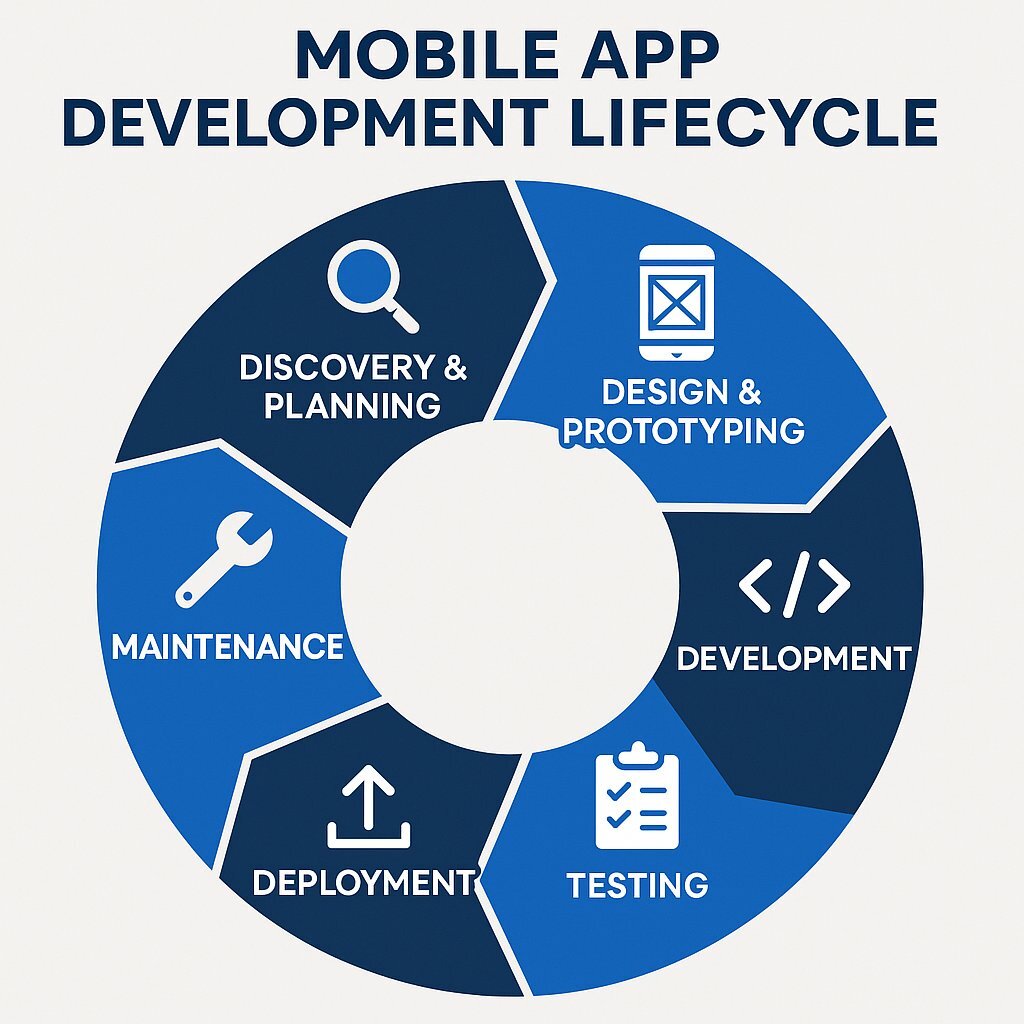
What Are Mobile App Development Services
Mobile app development services cover the process of creating software applications that run on mobile devices like smartphones and tablets. These services encompass the entire project lifecycle—from concept and strategy to design, development, testing, deployment, and maintenance.
A full service mobile app development company goes far beyond just coding. The development process starts with business analysis and requirements gathering, where developers work closely with clients to understand their goals, target audience, and specific functionality needs. This phase may also include market research and competitor analysis to ensure the app stands out in the app stores.
The core components of mobile app development services include user experience (UX) and user interface (UI) design, where designers create intuitive, visually appealing interfaces that follow platform guidelines. The development phase is where the actual coding happens—sometimes using cross-platform solutions to build the app’s functionality, integrating with backend systems, databases, and third-party APIs as needed. Quality assurance and testing is another crucial part, ensuring the app works on different devices, operating systems, and usage scenarios. This includes functional testing, performance optimization, security testing, and user acceptance testing before launch.
Post-launch support is equally important, including app store submission, ongoing maintenance, bug fixes, feature enhancements, and updates to keep the app compatible with new OS versions. Many development teams also provide analytics integration and performance monitoring to help businesses understand user behavior and continually optimize their apps.
Modern mobile app development services also address compliance requirements, ensuring apps meet industry regulations like HIPAA for healthcare apps or GDPR for those handling European user data. This comprehensive approach helps businesses create not just functional apps, but solutions that drive real business value and user engagement.
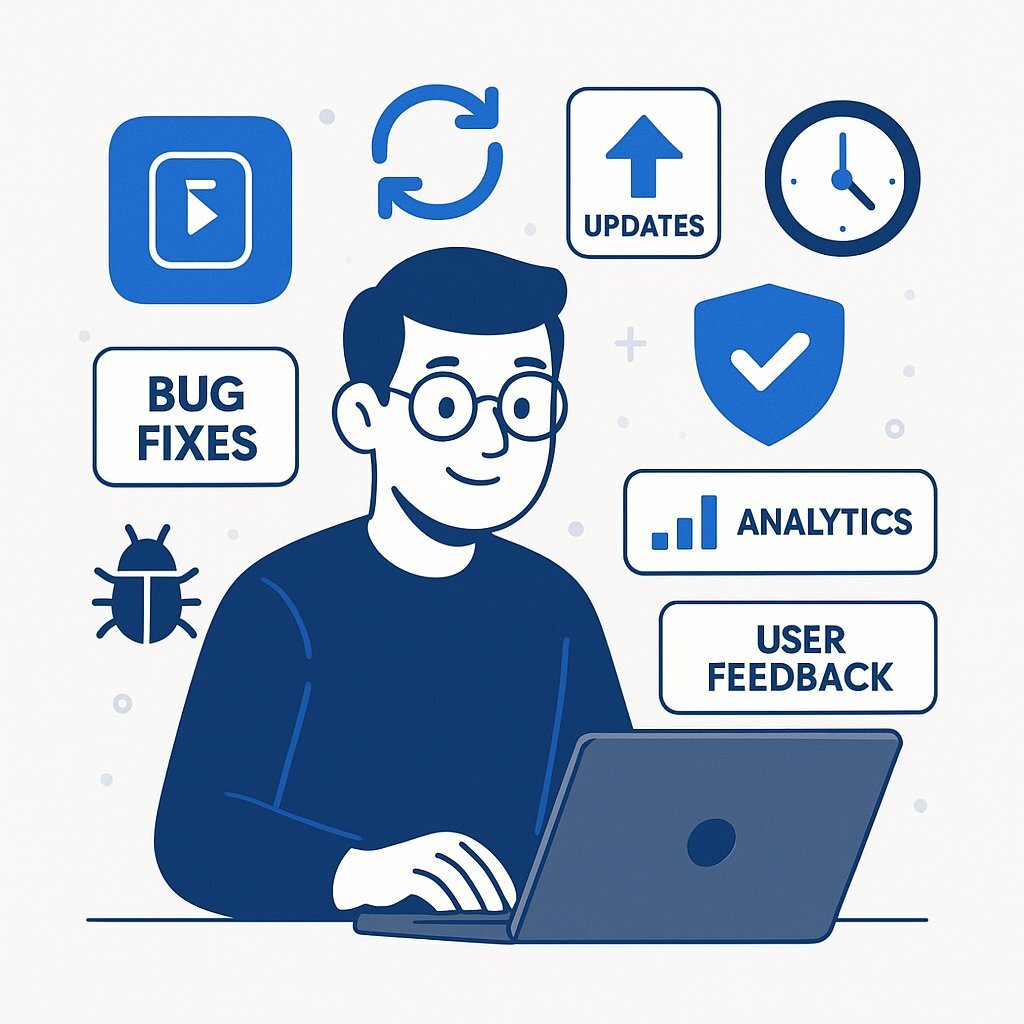
Types of Mobile App Development Services
Native App Development
Native app development means creating applications specifically for one platform using that platform’s native programming languages and tools. For iOS, this might involve Swift or Objective-C to create apps designed for iPhones, iPads, and Apple Watches. Android application development uses Java or Kotlin for the Android ecosystem.
Native apps offer several advantages that make them appealing for companies prioritizing performance and user experience. These apps can access all device features—camera, GPS, push notifications, and biometric authentication—providing seamless integration with the device’s hardware and software capabilities. Native development also allows for platform-specific optimization, resulting in better performance, faster load times, and smoother animations.
The user interface in native apps follows platform-specific design guidelines, so users feel comfortable and familiar with navigation and functionality. This adherence to platform conventions often leads to higher user satisfaction and better app store ratings.
However, native app development typically requires higher costs and longer development timelines, especially if targeting both Android and iOS. Businesses often need separate development teams or must develop for one platform first, then adapt the app to the other—essentially doubling the effort.
Cross-Platform Development
Cross-platform development has become a popular solution for businesses wanting to reach users on multiple platforms, while managing costs and timelines more efficiently. This approach lets developers write code once and deploy it across iOS and Android, reducing both development time and maintenance overhead.
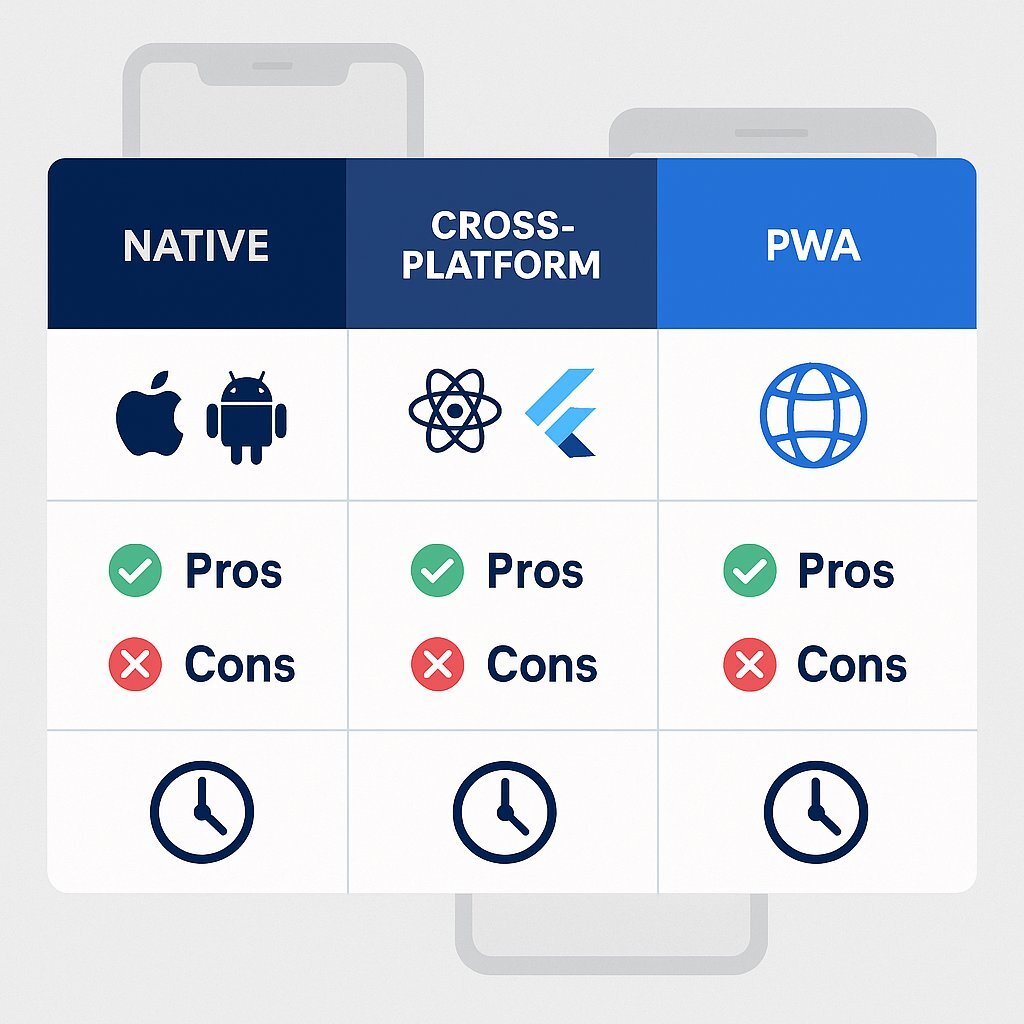
React Native, created by Meta, allows developers to use JavaScript and React concepts to build mobile applications that render native components. This framework has gained popularity because it enables web developers to transition into mobile development more easily while delivering near-native performance. Flutter, Google’s cross-platform framework, uses the Dart programming language to create high-performance applications with a single codebase. Flutter apps compile to native code, providing outstanding performance with consistent visuals across platforms and a rich set of customizable widgets for beautiful UI.
Xamarin, Microsoft’s cross-platform solution, lets developers write apps in C# and share business logic, while still accessing native APIs and features. That’s a big advantage, especially for enterprise applications relying on the Microsoft stack.
Cross-platform strategies typically reduce costs by 30–40% compared to building separate native apps for each platform. Teams can focus energy on a single codebase, making updates and maintenance more efficient and cost-effective.
Progressive Web Apps (PWA)
Progressive Web Apps represent a hybrid approach, bridging the gap between web and mobile. PWAs are web applications built using HTML, CSS, and JavaScript but deliver app-like experiences—including offline functionality, push notifications, and device integration.
A primary advantage of PWAs is universal accessibility across all devices and platforms, with no need for separate development efforts for each system. Users can install PWAs directly from their browsers—no app store visit required—eliminating delays and approval bottlenecks.
PWAs deliver cost savings compared to native approaches, letting businesses use existing web development skills and manage a single codebase. Updates are simpler, since changes propagate instantly without requiring users to download new app versions.
However, PWAs have limitations accessing certain device features and may not match native apps for performance in complex or graphics-intensive scenarios. They also receive limited support on iOS compared to Android, which can impact user experience for iPhone owners.
Mobile App Development Process
Discovery and Planning Phase
The process begins with a detailed discovery and planning phase that sets a strong foundation for success. During this stage, development teams conduct business analysis sessions to understand objectives, target audience, and the app’s unique requirements.
Market research is key here—teams analyze competitor apps, spot market gaps, and gain insights into user expectations. This research guides decisions about features, functionality, and strategies for standing out in the app store. Technical feasibility assessments follow, evaluating proposed features against available technologies, platform capabilities, and budget. The development team investigates integration requirements with existing systems, third-party services, and APIs, identifying all technical challenges early on.
Project timeline estimation and resource allocation happen in this phase as well. The team breaks down the process into manageable milestones and sprint cycles, setting realistic timelines and budgets and identifying risks or bottlenecks before they become issues.
Technology stack selection is another crucial step, where teams weigh languages, frameworks, and tools against project needs. Factors such as target platforms, scalability, performance, and team expertise influence these choices.
Design and Prototyping
The design phase transforms requirements into engaging, interactive experiences. User experience research comes first, using interviews, surveys, and behavioral analysis to understand how people actually use mobile apps.
Wireframing lays out basic structure, showing relationships between screens and how users will navigate the app. These wireframes serve as blueprints guiding visual design and ensuring all functionality is covered.
Interactive prototyping brings wireframes to life. Stakeholders can "try" the app before development, uncovering usability issues and gathering feedback before investing resources into development.
User interface design follows platform-specific guidelines so the app feels right at home, whether it’s on iOS or Android. Design consistency, using systems for color schemes, typography, iconography, and UI components, helps ensure a solid and professional presentation throughout the app lifecycle.
Development and Testing
The development phase often follows Agile methodology with 2–3 week sprint cycles. This approach allows teams to deliver working features incrementally and adapt to changing requirements while gathering regular client feedback.
Frontend development focuses on creating responsive user interfaces adaptable to multiple devices and screen sizes. Meanwhile, backend development powers the core functionality, handling server logic, databases, authentication, and API integrations.
DevOps tools ensure the development process is seamless, with automated testing, continuous integration, and deployment pipelines for efficient delivery of high-quality mobile apps. Docker containers, for example, keep environments consistent from development to production, reducing friction and bugs.
Quality assurance testing runs alongside development. The QA team conducts functional testing, makes sure performance is optimal, and carries out security tests to safeguard against vulnerabilities.
Beta testing with real users gives valuable insights on how the app performs and is experienced in the real world. This step typically uncovers usability issues or bugs unnoticed during in-house testing, paving the way for last-minute adjustments.
The app store submission and approval process involves creating listings, screenshots, optimized descriptions, and metadata—all while ensuring platform-specific compliance. Dev teams guide the client through every step, including troubleshooting any possible store rejections, and help maximize app visibility in search results.
Technology Stack and Platforms
Popular Technologies
There are many options for building mobile apps. Node.js and .NET are both powerful choices for backend development—Node.js is great for JavaScript developers building full-stack apps, while .NET suits enterprises already invested in Microsoft technologies.
For frontend development, React Native is widely used for cross-platform solutions—it lets developers use JavaScript while tapping into native device capabilities. Flutter, built around Dart, offers a fast, expressive toolkit and is gaining traction for cross-platform development.
Swift is the top choice for iOS, valued for performance and modern features; Kotlin is now the preferred language for Android, thanks to its improved syntax and reliability compared to Java.
The right database depends on your needs. PostgreSQL is robust for relational data, MongoDB provides flexibility with document storage, and Firebase offers backend services tailored for mobile. Cloud options like AWS DynamoDB offer scalability for high-performance apps.
Modern cloud platforms—including AWS, Microsoft Azure, and Google Cloud—also provide hosting, storage, analytics, and AI/ML services. These allow teams to focus purely on app features, leveraging proven infrastructure for the heavy lifting.
DevOps tools are indispensable for efficient workflows. Docker containers bring environment consistency, Jenkins and GitHub Actions drive automation, and continuous deployment replaces manual bottlenecks, enhancing quality and speed.
Emerging Technologies
Artificial Intelligence-powered features are now common in mobile apps, enabling personalized experiences, smart recommendations, and automated decision-making. Modern dev teams weave AI into mobile apps with chatbots, image recognition, and predictive analytics, making apps smarter and more engaging.
Augmented Reality and Virtual Reality are moving beyond gaming, giving businesses innovative ways to interact and educate. AR enables virtual product try-ons for shopping, while VR delivers immersive training for education and enterprise.
Internet of Things opens new possibilities—mobile apps connect with smart devices to control your environment, your car, or even industrial machinery from your phone.
Blockchain technology is emerging for secure, transparent transactions and decentralized identity management—especially relevant in finance, supply chains, and digital assets.
Voice assistants and chatbot integration are raising the bar for accessibility and ease of use, giving users more natural ways to interact with apps, including conversational or hands-free controls.
Mobile App Development Costs and Pricing Models
Cost Breakdown by App Complexity
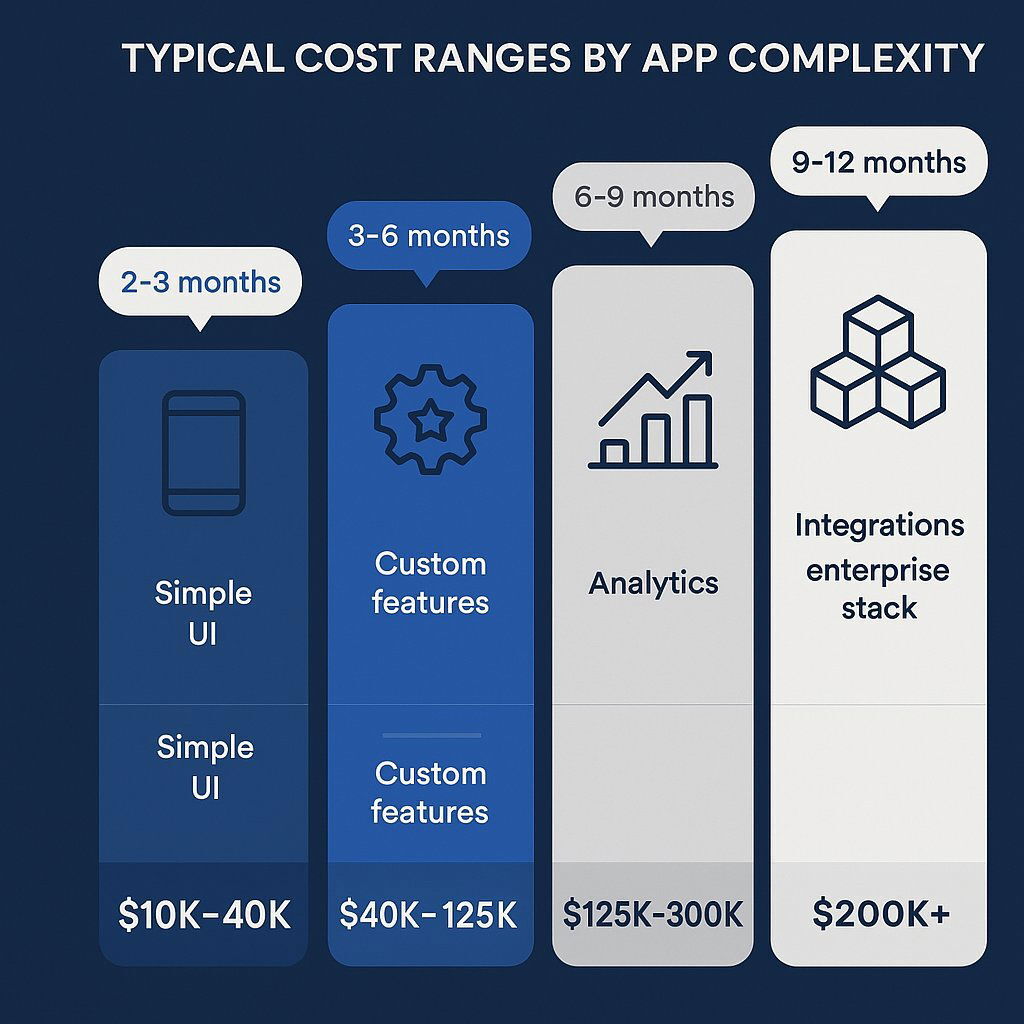
Mobile app development costs are mainly determined by app complexity and development effort. Simple apps cost between $10,000 and $40,000, typically handling user registration, basic content, and simple navigation. These take 2–4 months to create and fit businesses testing new ideas or providing essential info to customers.
Medium complexity apps cost $40,000–$125,000, with features like user profiles, social integration, payments, and real-time updates. These require custom backends, API integrations, and richer interfaces—4–6 months to build, usually by teams of 3–5 developers.
Complex apps, running $125,000–$300,000, add advanced capabilities such as machine learning, sophisticated analytics, and deep enterprise integrations. Larger organizations often need these for mission-critical platforms. Enterprise-level applications can exceed $200,000, have major compliance and integration requirements, and need greater security. These longer builds often stretch past 8 months and require specialized teams.
Maintenance costs are an ongoing investment—expect to spend 15–20% of the initial cost per year. This covers regular updates, fixes, security, and compatibility improvements for new OS versions. Keeping your app maintained ensures it stays functional and competitive.
Pricing Models
Fixed-price contracts make sense for projects with clear requirements and deliverables. This model brings budget predictability, but you’ll need a detailed plan and clear scope from the outset, as mid-project changes can be tricky.
Time and materials billing offers greater flexibility for evolving requirements. You pay for actual hours worked, making it the right model for projects where the scope may shift or grow as you learn more.
Dedicated team models provide ongoing partnerships—essentially remote dev teams committed to your project, ideal for long-term builds or continuous app improvement.
Milestone-based payments break work into phases, tying payments to specific deliverables such as design completion, MVP delivery, or full feature rollout. This approach lets both sides track progress and manage cash flow.
Hourly rates vary greatly by geography and expertise: North American developers often cost $75–$150 per hour, while Eastern Europe averages $25–$75. Offshore development (India, Southeast Asia) can be as low as $15–$50 per hour—though it's wise to weigh those savings against possible trade-offs in quality and communication.
How to Choose Mobile App Development Services
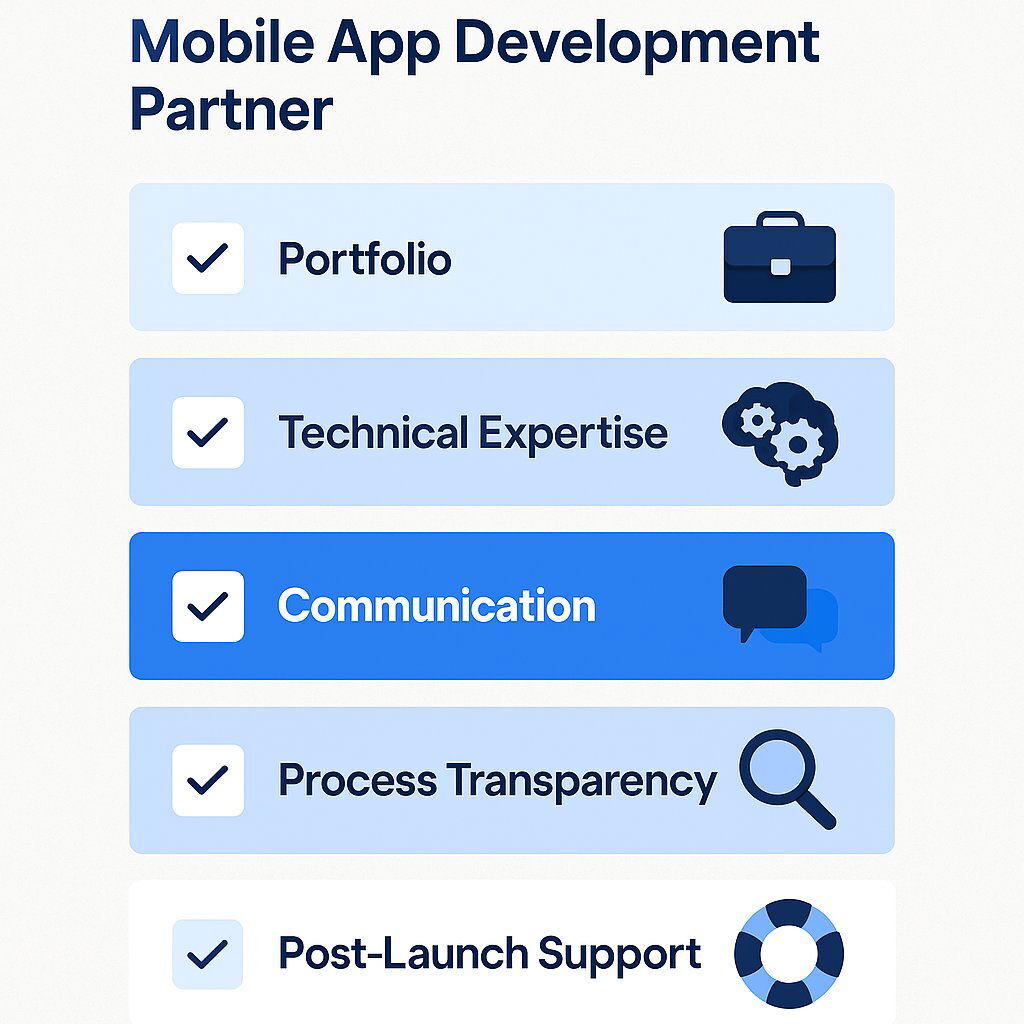
Evaluation Criteria
Choosing the right mobile app development company takes careful evaluation. Portfolio review is essential—look closely at completed apps similar to your industry or function, not just their user interface, but their ratings, performance, and real-world business results.
Assess technical expertise—it’s more than just knowing how to code. The best teams have deep platform knowledge, keep up with the latest frameworks, and understand how to apply security best practices or meet regulatory needs. That depth matters for everything from app store approvals to long-term user engagement.
Testimonials and case studies reveal how development teams work—pay attention to communication style, process transparency, and how they’ve solved challenges for others. The strongest partners can connect you with former clients so you can ask about their experience firsthand.
Transparency during the development process is vital. Reliable teams use proven project management methodologies, send regular updates, and keep communication clear from start to finish.
Don’t forget ongoing support—what matters is how your app performs after launch. Make sure the team offers strong post-launch support, with fast responses to critical issues and plans for continuous app improvement.
Red Flags to Avoid
Watch out for unrealistic timelines. Complex mobile apps can’t be rushed in a few weeks without cutting corners on security, testing, or user experience. If it sounds too good to be true, it probably is.
Extremely low pricing can signal hidden costs, inexperience, or shortcuts that affect quality. The cheapest upfront bid often leads to expensive fixes later.
A missing or vague portfolio is a red flag. Good teams are proud to show off past work and discuss their approach. If they’re hesitant or can’t provide examples, proceed with caution.
Notice communication style in early conversations. If a team is slow to respond or gives vague answers now, that habit will likely continue after the contract is signed—leading to misunderstandings down the road.
Finally, teams without clear project management discipline—no mention of Agile, Scrum, or established tools—are more likely to miss deadlines or deliver inconsistent results. Professional partners always have solid processes for managing change, testing, and releases.
Industry-Specific Mobile App Development
Healthcare and Telemedicine Apps
Healthcare mobile applications require specialized knowledge of regulatory compliance, particularly HIPAA requirements for patient data protection and privacy. Experienced teams must implement robust security, including end-to-end encryption and audit trails for all access to protected health information.
Integrating advanced analytics or personalization can also vastly improve patient engagement and health outcomes, turning a standard app into a true value-adding platform.
Electronic health record (EHR) integration is a technical challenge, demanding deep understanding of healthcare standards like HL7 FHIR. Seamless integration allows providers to access patient info reliably and maintain data consistency.
Telemedicine features must deliver high-quality video no matter the network, plus easy-to-use interfaces for both patients and providers—all while maintaining compliance.
Prescription management and appointment scheduling often connect with pharmacy systems, insurance networks, or provider calendars, requiring careful design for accuracy, privacy, and user experience.
Modern health apps increasingly integrate with wearables, giving real-time health data for monitoring and early intervention, benefiting both patients and care teams.
E-commerce and Retail Apps
E-commerce mobile applications need seamless shopping carts, secure payment gateways that support multiple payment methods, and full compliance with security standards like PCI DSS.
Inventory management integrations help keep product availability accurate across sales channels, avoiding disappointment and boosting customer trust.
Push notifications can drive engagement and sales—used well, they keep customers coming back without causing fatigue.
Some retailers employ rapid prototyping and MVP approaches to test new features, such as augmented reality for virtual product try-ons. These help reduce returns and build customer confidence—especially in industries like apparel or furniture.
Loyalty programs and personalized recommendation engines are built on user data and purchase history, increasing retention and offering valuable business intelligence.
Financial Services Apps
Security and risk management are non-negotiable in financial applications—teams must use advanced encryption, rigorous authentication, and stay vigilant against evolving cyber threats through regular audits.
Immediate, real-time transaction processing and monitoring are expected, with accuracy, performance, and instant fraud detection baked in as standard.
Biometric authentication—fingerprint or face recognition—gives users seamless and secure sign-ins, while also offering flexible accessibility options for all users.
Regulatory compliance covers a spectrum, from PCI DSS for payments to SOX and Basel III for financial institutions, so teams need deep, current compliance knowledge.
Integrating with core banking systems or third-party APIs often involves legacy architectures—smart planning and rigorous testing are critical for robust, high-performing financial apps.
FAQ
How long does it take to develop a mobile app?
Most mobile apps take 3–8 months to develop, depending on their complexity and feature set. Simple apps might only take 2–4 months, while larger enterprise applications can take 8–12 months or longer. This includes all phases—planning, design, development, testing, and app store submission. Opting for modern AI-powered development tools or cross-platform frameworks may help reduce overall timelines, but your precise schedule will depend on features, team size, and how deeply you need to integrate with external systems.
What’s the difference between native and cross-platform development costs?
Cross-platform development typically costs 30–40% less than building separate native apps for iOS and Android. For example, while native development can run $80,000–$160,000 for both platforms, cross-platform solutions (like React Native or Flutter) could deliver the same functionality for $50,000–$100,000 total. However, for apps demanding elite performance or advanced device integration, the extra investment for native builds might be worthwhile.
Do I need separate development teams for iOS and Android apps?
Not always. Many companies offer full-stack teams skilled in both platforms. Approaches like Flutter or React Native mean one team can craft apps for iOS and Android simultaneously, streamlining communication and saving money. That said, for 100% native builds, you’ll still need experts in each—though lots of developers now work comfortably across the boundaries.
What support can I expect after app launch?
Reliable development teams will provide ongoing maintenance and support—including bug fixes, OS updates, security patches, performance monitoring, and feature upgrades. Maintenance packages typically cost 15–20% of initial development costs per year, covering all updates and SLAs for hosting or technical help. This ongoing relationship is key to staying highly rated in the app store and maintaining user satisfaction as tech and security standards evolve.
How do I protect my app idea during development?
Reputable companies will sign NDAs at the beginning of discussions. You can also protect your intellectual property with formal filings, code obfuscation, and by working with teams who enforce strong security practices and compliance certifications. Experienced partners understand commercial confidentiality and already have protocols to protect your ideas at every stage of development.
About Baytech
At Baytech Consulting, we specialize in guiding businesses through this process, helping you build scalable, efficient, and high-performing software that evolves with your needs. Our MVP first approach helps our clients minimize upfront costs and maximize ROI. Ready to take the next step in your software development journey? Contact us today to learn how we can help you achieve your goals with a phased development approach.
About the Author

Bryan Reynolds is an accomplished technology executive with more than 25 years of experience leading innovation in the software industry. As the CEO and founder of Baytech Consulting, he has built a reputation for delivering custom software solutions that help businesses streamline operations, enhance customer experiences, and drive growth.
Bryan’s expertise spans custom software development, cloud infrastructure, artificial intelligence, and strategic business consulting, making him a trusted advisor and thought leader across a wide range of industries.


